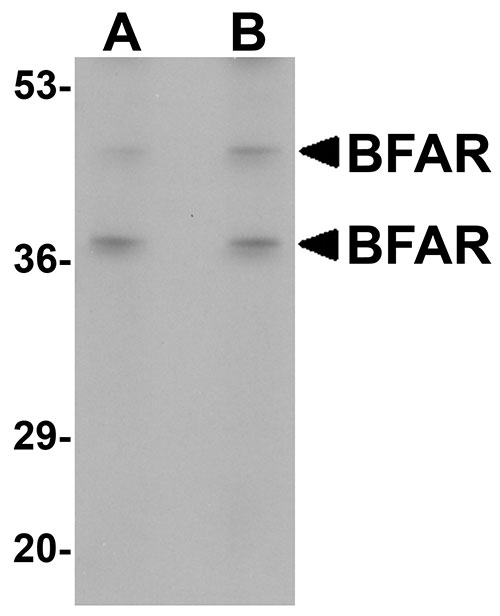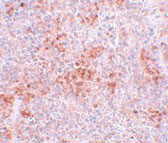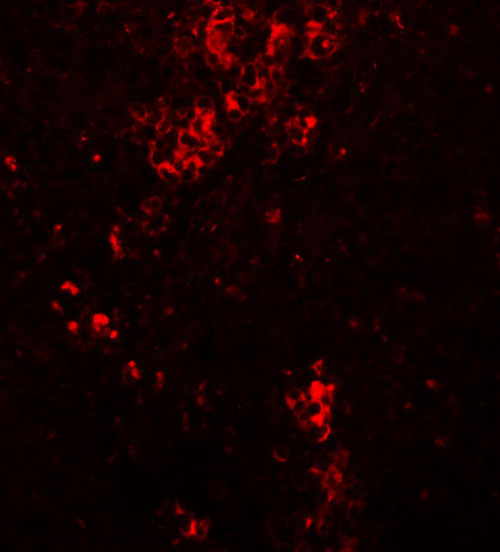BFAR Antibody
- SPECIFICATION
- CITATIONS
- PROTOCOLS
- BACKGROUND

Application
| WB, IHC-P, IF, E |
|---|---|
| Primary Accession | Q9NZS9 |
| Other Accession | NP_057645, 7706091 |
| Reactivity | Human, Mouse, Rat |
| Host | Rabbit |
| Clonality | Polyclonal |
| Isotype | IgG |
| Calculated MW | 52738 Da |
| Application Notes | BFAR antibody can be used for detection of BFAR by Western blot at 1 - 2 µg/mL. Antibody can also be used for immunohistochemistry starting at 5 µg/mL. For immunofluorescence start at 20 µg/mL. |
| Gene ID | 51283 |
|---|---|
| Target/Specificity | BFAR; |
| Reconstitution & Storage | BFAR antibody can be stored at 4℃ for three months and -20℃, stable for up to one year. As with all antibodies care should be taken to avoid repeated freeze thaw cycles. Antibodies should not be exposed to prolonged high temperatures. |
| Precautions | BFAR Antibody is for research use only and not for use in diagnostic or therapeutic procedures. |
| Name | BFAR |
|---|---|
| Synonyms | BAR, RNF47 |
| Function | Membrane-bound E3 ubiquitin ligase that plays a role in several processes including apoptosis regulation or reticulum endoplasmic stress (PubMed:14502241, PubMed:21068390). Has anti- apoptotic activity, both for apoptosis triggered via death-receptors and via mitochondrial factors (PubMed:14502241). Contributes to the dynamic control of IRE1/ERN1 signaling during ER stress by inducing BAX inhibitor 1/TMBIM6 proteasomal degradation (PubMed:21068390). Promotes the activation of TGF-beta signaling by mediating the 'Lys-63'-linked ubiquitination of TGFBR1 which is critical to activate the pathway (PubMed:33914044). Together with NGFR, negatively regulates NF-kappa-B and JNK-related signaling pathways (PubMed:22566094). Promotes the proteasome-mediated degradation of PNPLA3, a protein involveld in lipid metabolism (PubMed:38294943). |
| Cellular Location | Endoplasmic reticulum membrane; Multi-pass membrane protein |
| Tissue Location | Expressed highly in brain, moderately in small intestine, weakly in testes and only faintly in liver and skeletal muscle. Not expressed in heart, kidney, lung and spleen |

Thousands of laboratories across the world have published research that depended on the performance of antibodies from Abcepta to advance their research. Check out links to articles that cite our products in major peer-reviewed journals, organized by research category.
info@abcepta.com, and receive a free "I Love Antibodies" mug.
Provided below are standard protocols that you may find useful for product applications.
Background
BFAR Antibody: The bifunctional apoptosis inhibitor (BFAR) is scaffold protein that integrates signaling components of the cells apoptosis-regulatory machinery. BFAR is a multidomain protein capable of inhibiting apoptosis induced by TNF-family death receptors ('extrinsic pathway') as well as mitochondria-dependent apoptosis ('intrinsic pathway'). Interaction of BFAR with Bcl-2 or Bcl-XL via a SAM domain may contribute to the anti-apoptotic properties of BFAR. In addition, BFAR contains a DED-like domain that is capable of suppressing apoptosis mediated at the receptor level. BFAR is also thought to be involved in the regulation of neuronal survival.
References
Zhang H, Xu Q, Krajewski S, et al. BAR: an apoptosis regulator at the intersection of caspases and Bcl-2 family proteins. Proc. Natl. Acad. Sci. USA2000; 97:2597-602.
Roth W, Kermer P, Krajewska M, et al. Bifunctional apoptosis inhibitor (BAR) protects neurons from diverse cell death pathways. Cell Death Differ. 2003; 10: 1178-87.
If you have used an Abcepta product and would like to share how it has performed, please click on the "Submit Review" button and provide the requested information. Our staff will examine and post your review and contact you if needed.
If you have any additional inquiries please email technical services at tech@abcepta.com.













 Foundational characteristics of cancer include proliferation, angiogenesis, migration, evasion of apoptosis, and cellular immortality. Find key markers for these cellular processes and antibodies to detect them.
Foundational characteristics of cancer include proliferation, angiogenesis, migration, evasion of apoptosis, and cellular immortality. Find key markers for these cellular processes and antibodies to detect them. The SUMOplot™ Analysis Program predicts and scores sumoylation sites in your protein. SUMOylation is a post-translational modification involved in various cellular processes, such as nuclear-cytosolic transport, transcriptional regulation, apoptosis, protein stability, response to stress, and progression through the cell cycle.
The SUMOplot™ Analysis Program predicts and scores sumoylation sites in your protein. SUMOylation is a post-translational modification involved in various cellular processes, such as nuclear-cytosolic transport, transcriptional regulation, apoptosis, protein stability, response to stress, and progression through the cell cycle. The Autophagy Receptor Motif Plotter predicts and scores autophagy receptor binding sites in your protein. Identifying proteins connected to this pathway is critical to understanding the role of autophagy in physiological as well as pathological processes such as development, differentiation, neurodegenerative diseases, stress, infection, and cancer.
The Autophagy Receptor Motif Plotter predicts and scores autophagy receptor binding sites in your protein. Identifying proteins connected to this pathway is critical to understanding the role of autophagy in physiological as well as pathological processes such as development, differentiation, neurodegenerative diseases, stress, infection, and cancer.




